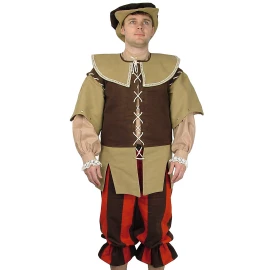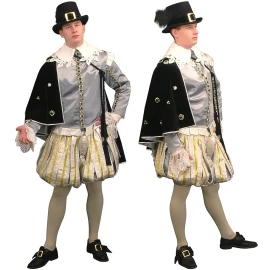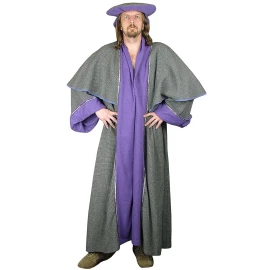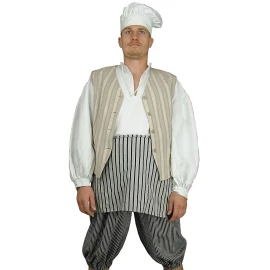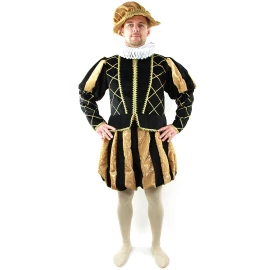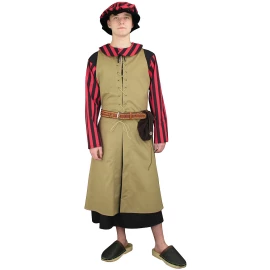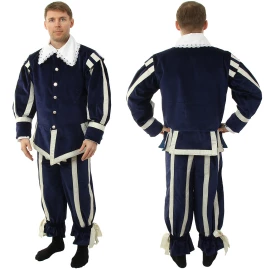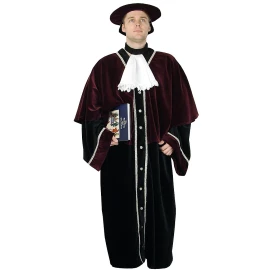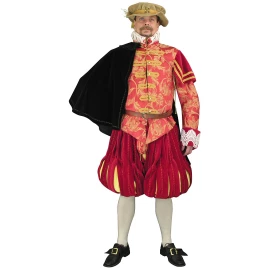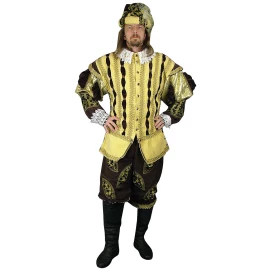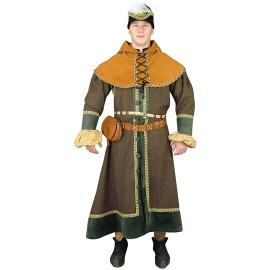Historical Renaissance Men's Clothing
Interestingly, menswear in the 16th century was much more form-rich and faster-changing than that of the ladies. Partly at intervals of 10 years, the look changed. However, the reference to military forms prevails. There was a steady flow of armed conflict, and so the forms of armor and Landsknechtsmode also penetrated into the civilian sphere. An example of this is the new shape of the doublet: fitted and fitted with longitudinal ropes, it should imitate the armor's breastplate.
Filter products
Historical Renaissance Men's Clothing
In contrast to Gothic, which favoured tight-fitting clothing for men, the robes now became voluminous, using much of the material that made the garment swing when it moved. The piebald, which was taken from the Gothic, changed its shape several times. At the end of the 15th century, the neckline became deeper and the men also revealed the underlying shirt, as this portrait by Lorenzo il Magnifico shows.
This gave the opportunity to decorate this rich as well. In addition, from the gothic ever shorter piebald now a partially knee-length garment, which was practically divided into four: straight and cut top, right and left sleeve and bottom, which resembled a knee-length skirt. Already between 1520 and 1530, however, the décolleté disappears again and the piebald is high-necked. From the shirt, only the collar can be seen, which is therefore embroidered elaborately.
Another reference to the Armor was the Koller; If this garment used to be worn under the armour to prevent scuffing, it was now worn as outerwear. While the original variant was made of leather, fabric was now used and also slit and embroidered like all other garments.
New was the Schaube, a coat often fur coat, which gave the figure a square appearance, here to see very nice with Karl V. Interesting in this picture is also the production of pants, which actually consisted of three pants:
- at the bottom a tight pants made of linen, which, however, had no real front part. It consisted of a part that covered the buttocks and that with ribbons that were crossed at the front and held a waistband. The pant legs of all three layers (underpants, trousers and outer fabric) are only attached to this part. The Koller had to be long enough to cover up the bare house. In order to avoid embarrassing confusion and the ladies not unnecessarily echauffieren, the noble parts were covered by the shame capsule.
- The feeding pants are a bit wider than the underpants.
- The upper pants consists of juxtaposed longitudinal strips, which are attached to horizontal stripes.
Particularly popular in the Renaissance emblems, which were partially provided with a motto. Different shapes had a specific meaning, which indicated the attitude of the wearer. By wearing these emblems (for example, on the beret) they demonstrated their education by proving that they knew their meaning. With the peculiarity of their own clothes one wanted to stand out from others. In fact, Baldassare Castiglione complains in his book "Il Cortigiano" (the courtier) that, in contrast to the ideal of the nobleman inserting himself into the community, clothing would become ever more elaborate and individual. The influences from abroad would increase more and more and there would be no more typical Italian fashion.
An example of an extraordinary garment is also the engagement portrait of Henry the Pious. This robe was made from two layers of fabric. The underside is yellow, the outer material red. The flame effect was achieved by cutting into the outer fabric-shaped slots, then the resulting strips were twisted and locked with basting stitches. As a result, the underlying feed can be seen. Slots were also inserted for the crossbeams and the fabric including lining was rolled outwards. (So it must have been 2 layers of yellow). In addition, at the elbow height bells were sewn in the form of a pomegranate, which should symbolize happiness and prosperity.
On the Cranach paintings is often no elaborately designed jewellery to see, but only the coarse chip chains. In fact, these served only the display of wealth. If necessary, a member could be cut out and used as a means of payment.
A striking difference to the women's fashion is the choice of fabrics. While ladies often wore patterned fabrics, men's garments were made of plain fabrics, but elaborately embroidered. A beautiful example is this robe of Franz I of France. Here all elements were embroidered before joining. It is also nice to see the ideal of the "warrior" here. The broad shoulder patches were taken from the armour.

